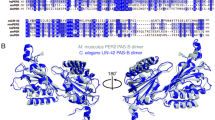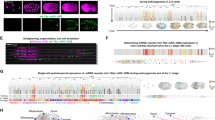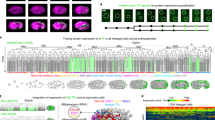Abstract
The C. elegans heterochronic gene pathway consists of a cascade of regulatory genes that are temporally controlled to specify the timing of developmental events1. Mutations in heterochronic genes cause temporal transformations in cell fates in which stage-specific events are omitted or reiterated2. Here we show that let-7 is a heterochronic switch gene. Loss of let-7 gene activity causes reiteration of larval cell fates during the adult stage, whereas increased let-7 gene dosage causes precocious expression of adult fates during larval stages. let-7 encodes a temporally regulated 21-nucleotide RNA that is complementary to elements in the 3′ untranslated regions of the heterochronic genes lin-14, lin-28, lin-41, lin-42 and daf-12, indicating that expression of these genes may be directly controlled by let-7. A reporter gene bearing the lin-41 3′ untranslated region is temporally regulated in a let-7-dependent manner. A second regulatory RNA, lin-4, negatively regulates lin-14 and lin-28 through RNA–RNA interactions with their 3′ untranslated regions3,4. We propose that the sequential stage-specific expression of the lin-4 and let-7 regulatory RNAs triggers transitions in the complement of heterochronic regulatory proteins to coordinate developmental timing.
This is a preview of subscription content, access via your institution
Access options
Subscribe to this journal
Receive 51 print issues and online access
$199.00 per year
only $3.90 per issue
Buy this article
- Purchase on SpringerLink
- Instant access to full article PDF
Prices may be subject to local taxes which are calculated during checkout





Similar content being viewed by others
References
Ambros, V. A hierarchy of regulatory genes controls a larva-to-adult developmental switch in C. elegans. Cell 57, 49– 59 (1989).
Ambros, V. & Horvitz, H. R. Heterochronic mutants of the nematode Caenorhabditis elegans. Science 226 , 409–416 (1984).
Lee, R. C., Feinbaum, R. L. & Ambros, V. The C. elegans heterochronic gene lin-4 encodes small RNAs with antisense complementarity to lin-14. Cell 75, 843–854 ( 1993).
Moss, E. G., Lee, R. C. & Ambros, V. The cold shock domain protein LIN-28 controls developmental timing in C. elegans and is regulated by the lin-4 RNA. Cell 88, 637–646 ( 1997).
Meneely, P. M. & Herman, R. K. Lethals, steriles, and deficiencies in a region of the X chromosome of Caenorhabditis elegans. Genetics 92, 99–115 ( 1979).
Sulston, J. E. & Horvitz, H. R. Post-embryonic cell lineages of the nematode Caenorhabditis elegans. Dev. Biol 56, 110–156 (1977).
Rougvie, A. E. & Ambros, V. The heterochronic gene lin-29 encodes a zinc finger protein that controls a terminal differentiation event in Caenorhabditis elegans. Development 121, 2491–2500 (1995).
Bettinger, J. C., Lee, K. & Rougvie, A. E. Stage-specific accumulation of the terminal differentiation factor LIN-29 during Caenorhabditis elegans development. Development 122, 2517–2527 (1996).
Liu, Z. Genetic Control of Stage-Specific Developmental Events in C. elegans. Thesis, Harvard Univ. (1990).
Abrahante, J. E., Miller, E. A. & Rougvie, A. E. Identification of heterochronic mutants in Caenorhabditis elegans: temporal misexpression of a collagen::green fluorescent protein fusion gene. Genetics 149, 1335– 1351 (1998).
Kennedy, B. P. et al. The gut esterase gene (ges-1) from the nematodes Caenorhabditis elegans and Caenorhabditis briggsae. J. Mol. Biol. 229, 890–908 (1993).
Zucker-Sparison, E. & Blumenthal, T. Potential regulatory elements of nematode vitellogenin genes revealed by interspecies sequence comparison. J. Mol. Evol. 28, 487– 496 (1989).
Wightman, B. et al. Negative regulatory sequences in the lin-14 3′-untranslated region are necessary to generate a temporal switch during Caenorhabditis elegans development. Genes. Dev. 5, 1813–1824 (1991).
Yeh, W. H. Genes Acting Late in the Signaling Pathway for Caenorhabditis elegans Dauer Larval Development. Ph.D. Thesis. University of Missouri, Columbia, MO (1991).
Jeon, M., Gardner, H. F., Miller, E. A., Deshler, J. & Rougvie, A. E. Similarity of the C. elegans developmental timing protein LIN-42 to circadian rhythm proteins. Science 286, 1141–1146 ( 1999).
Wightman, B., Ha, I. & Ruvkun, G. Posttranscriptional regulation of the heterochronic gene lin-14 by lin-4 mediates temporal pattern formation in C. elegans. Cell 75, 855–862 ( 1993).
Feinbaum, R. & Ambros, V. The timing of lin-4 RNA accumulation controls the timing of postembryonic developmental events in C. elegans . Dev. Biol. 210, 87– 95 (1999).
Trent, C., Tsung, N. & Horvitz, H. R. Egg-laying defective mutants of the nematode Caenorhabditis elegans. Genetics 104, 619–647 (1983).
Segalat, L., Elkes, D. A. & Kaplan, J. M. Modulation of serotonin-controlled behaviors by G o in Caenorhabditis elegans. Science 267 , 1648–1651 (1995).
Ausubel, F. M. et al. Current Protocols in Molecular Biology (John Wiley & Sons, New York, 1995).
Devereux, J., Haeberli, P. & Smithies, O. A comprehensive set of sequence analysis programs for the VAX. Nucleic Acids Res. 12, 387– 395 (1984).
Acknowledgements
We thank the C. elegans Genome Sequencing Consortium for sequence data, A. Coulson and the Sanger Centre for cosmids, the Caenorhabditis Genetics Center and V. Ambros for providing strains and sharing unpublished results. We thank R. Feinbaum for advice concerning experimental procedures and Y. Liu and P. Delerme for technical assistance. This work was supported by NIH grants to G.R., H.R.H. and A.R., and an NIH postdoctoral fellowship to F.S. H.R.H. is an Investigator of the Howard Hughes Medical Institute.
Author information
Authors and Affiliations
Rights and permissions
About this article
Cite this article
Reinhart, B., Slack, F., Basson, M. et al. The 21-nucleotide let-7 RNA regulates developmental timing in Caenorhabditis elegans. Nature 403, 901–906 (2000). https://doi.org/10.1038/35002607
Received:
Accepted:
Issue Date:
DOI: https://doi.org/10.1038/35002607



